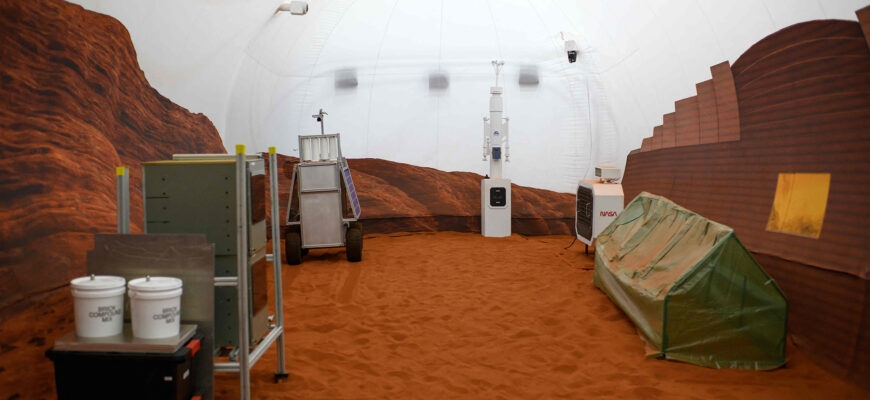The allure of Mars has captivated humanity for centuries. From ancient observers tracing its crimson path across the night sky to modern scientists dreaming of boots on its dusty surface, the Red Planet remains our most intriguing celestial neighbor. But before we can truly establish a human presence there, a monumental amount of preparation is required. This isn`t just about rockets and landers; it`s about the humans themselves.
In a critical step forward, NASA is embarking on a year-long simulation designed to peel back the curtain on the psychological and physiological realities of living on Mars. Scheduled to commence on October 19, 2025, this ambitious experiment, known as the Crew Health and Performance Exploration Analog (CHAPEA), will place four dedicated volunteers into a meticulously crafted, 3D-printed Martian habitat right in the heart of Houston, Texas.
The Mars Dune Alpha: A Terrestrial Red Planet Enclave
Forget the sprawling complexes of science fiction; NASA`s chosen habitat for this endeavor is a 1,700-square-foot (158-square-meter) structure affectionately named “Mars Dune Alpha.” Crafted with the innovative efficiency of a 3D printer, this module is more than just a glorified living space; it`s a crucible designed to replicate the constraints and challenges of a genuine Martian outpost. While the view outside won`t be crimson dust storms, the internal experience promises to be just as… Martian.
For 378 days, these four individuals will experience life as close to a Mars mission as current technology allows without leaving Earth`s gravity well. This isn`t a luxurious retreat; it`s a rigorous test of endurance, ingenuity, and teamwork. The mission is slated to conclude on October 31, 2026, marking a significant milestone in our journey to interplanetary living.
Meet the Trailblazers: More Than Just Volunteers
The individuals selected for this isolated year-long `staycation` are far from ordinary. They are a diverse quartet, each bringing a unique and invaluable skillset to the simulated Martian landscape:
- Ross Elder: A US Air Force test pilot, bringing invaluable experience in high-pressure operational environments and complex systems management.
- Ellen Ellis: A Colonel and medic from the US Space Force, whose expertise will be critical for managing crew health and emergency scenarios.
- Matthew Montgomery: A seasoned scientist and engineer, prepared to tackle the technical and research demands of a long-duration mission.
- James Spicer: A technical director from the aerospace and defense industry, whose strategic and problem-solving capabilities will be essential for mission success.
This isn`t just a group of friends sharing a very small, isolated house; it`s a carefully assembled team whose interactions, challenges, and triumphs will provide vital lessons for future crews embarking on actual journeys to Mars.
Life on “Mars”: The Harsh Realities Simulated
The CHAPEA mission is meticulously designed to simulate the less glamorous, yet critically important, aspects of living on Mars. The volunteers will contend with a host of realistic constraints, all while maintaining their scientific and operational duties:
- Resource Limitations: Every drop of water, every calorie of food, every watt of power will be carefully monitored and rationed, mirroring the scarcity inherent in off-world habitats.
- Equipment Failures: Unpredictable system malfunctions will test the crew`s problem-solving skills and resilience, forcing them to adapt and repair with limited tools and remote support.
- Communication Delays: The vast distances of space mean communication with Earth will be subject to significant time lags, simulating the isolation and requiring independent decision-making.
- Isolation and Confinement: Living in close quarters with the same few individuals for over a year, far from external stimuli, will be a profound psychological challenge.
- Limited Mobility: The small habitat and the need for simulated extravehicular activities (EVAs) will enforce physical constraints, much like life on a remote planetary outpost.
Beyond these stresses, the crew will be constantly engaged in purposeful work. Their daily regimen includes conducting scientific research, performing operational tasks, growing vegetables in their Martian garden (a critical skill for self-sufficiency), and operating robotic equipment. It`s a blend of cutting-edge science and very practical, often tedious, survival tasks.
Data Collection: The Science of Survival
The primary goal of CHAPEA is not just to see if humans *can* do it, but *how* they do it. NASA is keenly focused on gathering comprehensive data on the crew`s cognitive and physical performance. This involves continuous monitoring of their decision-making abilities, stress levels, sleep patterns, physical fitness, and overall well-being. Understanding the long-term effects of resource constraints and prolonged isolation on crew health and operational effectiveness is paramount.
“The team will live and work as astronauts for 378 days,” NASA stated, “providing invaluable insights into the human element of deep-space exploration.”
This information will directly inform the design of future spacecraft, habitats, and mission protocols, ensuring that when humans finally journey to Mars, they are as prepared as possible for the rigors and unique demands of the environment.
The Road Ahead: From Simulation to Reality
This ground-based simulation is a tangible precursor to humanity`s grander ambitions. Earlier statements from US officials, including the acting head of NASA, Sean Duffy, have reiterated the plan to send humans to Mars in the early 2030s. Such a mission would span over eight months for travel alone, with astronauts expected to remain on the planet`s surface before making the long return journey to Earth.
The lessons learned from Mars Dune Alpha will be instrumental in making those future missions not just possible, but successful. Every simulated equipment failure, every communication delay, every moment of shared isolation provides a piece of the puzzle that will help engineers and scientists build better systems and prepare better astronauts.
As the four volunteers prepare to seal themselves off from Earth`s comforts, they embark on a journey of discovery that transcends the walls of their 3D-printed home. Their year-long commitment will bring us one step closer to transforming the ancient dream of human presence on Mars into a meticulously planned and scientifically informed reality. The Red Planet beckons, and thanks to efforts like CHAPEA, we are steadily paving the path to answer its call.







